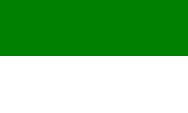


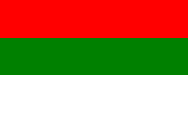
1863–1934,
Flag of the country and official flag,
Quelle/Source: nach/by: World Statesmen



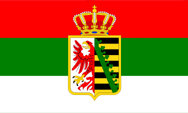
1863–1918,
Flag of the Duke,
Quelle/Source: nach/by: Flags of the World





The colors of the Ascanians were red, green and white, but in practice were used almost exclusively white and green, including the flags of the Duchies of Anhalt and their dynastic lines, which should have been furthermore square. The origin of the colors is unknown. It is believed that the red goes back to the red eagle of Brandenburg, the green to the octothorpe in the coat of arms of Saxony, and the white to the initial coat of arms of the Ascanians that showed the colors black and white. The cockades of the country showed only the color green.
There existed dynastic arms, which showed all the possessions and acquisitions, however, played the small arms the greater role, that for all of the family lines was the same. It showed in equal parts Brandenburg and Saxony, remembering the Margraves of Brandenburg and Dukes of Saxony (both from the House of Ascanians).
Another incident for the flag was the seizure of power by the National Socialists in the German Empire in 1933. All official non-swastika flags, that refered to federalism, regional references or the old German Empire were abolished between 1933 and 1935. For the National Socialists, the federal structure of the German Empire, its historically grown countries, was considered as outdated, as relics of a past to be overcome. In this sense, several laws were enacted, on 31st of March in 1933 the 'Provisional Law for the phasing of the countries with the Empire', on 7th of April 1933 the 'Second Law for the phasing of the countries with the Empire' and finally, on 30th January in 1934 the 'Law on the rebuilding of the empire'. Thus, the federal structure of the German Empire was replaced by the gau-structure of the NSDAP, the countries became meaningless. From now on, offices and authorities had to use the swastika flag as official flag, until September 15th in 1935, when by the flag-law was legislated a new created official flag for all the offices and authorities of the empire. The prime ministers of the countries, which latest in 1933 all came from the NSDAP – now mostly called Reichsstatthalter (maybe translated as 'governor') – however remained in office until 1945. The corresponding country colours continued, with restrictions, but definitly not in the form of flags. They were used, for example, occasionally on uniforms of the SA or in some ranks of the Hitler Youth in the breast cord.
After the war, the administration within the German Empire was rebuilt, but locally, following the structure of the countries. These have been partly old countries, and some new countries were created. Sometimes they bethought the old country colours and reactivated them – or they created new ones – for limited sovereign duties, which were under the control of the Allies. With the founding of the FRG and the GDR, an internal country-structure was finalised for both entities and corresponding official flags were introduced for these countries.
Quelle/Source: Historisches Deutschland,
Hof- und Staatshandbuch für das Herzogtum Anhalt, Dessau 1887,
Jürgen Kaltschmitt,
Uniform-Fibel


10th–12th cent., coat of arms of the Ascanians of Aschersleben,
Quelle/Source: nach/by:
Wikipedia (D)

ca. 1157–1180, coat of arms of the Ascanians as Margraves of Brandenburg and Counts of Ballenstedt,
Quelle/Source: nach/by:
Wikipedia (D),
Heraldique Europeenne

1180–1422, coat of arms of the Ascanians as Margraves of Brandenburg and Dukes of Saxony,
Quelle/Source: nach/by:
Wikipedia (D)

17th cent.,
middle coat of arms of the Principalities of Anhalt,
Quelle/Source: nach/by: Wikipedia (D),
Heraldique Europeenne

1806–1918,
lesser coat of arms of the Duchies of Anhalt,
Quelle/Source: nach/by:
Wikipedia (D)

1807–1918,
middle coat of arms Duchy of Anhalt(-Dessau),
Quelle/Source: nach/by: Wikipedia (D),
Heraldique Europeenne

1918–1945,
coat of arms Free State of Anhalt,
Quelle/Source: nach/by: Wikipedia (D)

The initial coat of arms of the Ascanians is the black-white checkerboard patterned shield with 12 fields. It goes back to the family which first lived in the castle "Askania", and which as "The Ascanians" acquired large landholdings, and became the most powerful families of the German Empire, between the 10th and 14th century. The name "Askania" is the Latin name of the place Aschersleben.
The castle Askania was destroyed already in the 12th century, and the emphasis of government shifted to Ballenstedt castle, which also became evident in the coat of arms. When the Ascanians became the Margraves of Brandenburg in 1157, they used a splited shield, to the left Brandenburg and on the right Ballenstedt, and as they became even the Dukes of Saxony in 1180, Ballenstedt was replaced by Saxony, and the until today used small coat of arms of the House of Anhalt was created, however, it later became a claim arms, because the Princes and Dukes of Anhalt were and are related by marriage with the Electors of Brandenburg and as well with those of Saxony, and claimed inheritance rights in both countries.
They combined in their arms the crests of the two often feuding countries, in a so-called claim arms. In this way were not only combined the arms of Saxony and Brandenburg for Anhalt, but also the since 1863 in the Duchy of Anhalt used colours red, green and white are a combination of the colours of Saxony (white and green) and Brandenburg (red and white).
The coat of arms of the Duchy of Saxony, which is until today the emblem of the Free State of Saxony, was created about 1180, as the Ascanians, Margraves of Brandenburg and Counts of Ballenstedt became to the Dukes of Saxony: over the coat of arms of Ballenstedt was placed a green diamond wreath.
All lines of the House of Anhalt used the same dynastic, middle coat of arms, and even the same lesser coat of arms. In the 18th century arose for Anhalt-Zerbst and Anhalt Köthen deviations in the middle coats of arms. Anhalt-Dessau and Anhalt-Bernburg retained their same shaped coats of arms.
The coat of arms of the since 1863 existing Duchy of Anhalt is the coat of arms of the only surviving line, the House of Anhalt-Dessau. It is very abundantly partitioned and shows altogether twelve fields, which reflect the heraldic smithereens of the familie's lines or territorial acquisitions: Duchy of Saxony, Palatinate of Saxony, Duchy of Engern, Beringen, Ballenstedt, Askanien, Waldersee, Warmsdorf, Mühlingen, the red regalia field (display of blood jurisdiction) and Bernburg. In the middle of the coat of arms, over field no. 5, a heart-shield. That shows the smaller coat of arms a splited shield, to the left Brandenburg and on the right Saxony.
The coat of arms of the Free State of Anhalt showed the bear of Bernburg, who played a larger role in the heraldry of all lines of the House of Anhalt, and it oftenly appeared on coins of the Anhalt states.
Quelle/Source: Heraldique Europeenne,
Volker Preuß


to 1919, Cockade of Anhalt,
Quelle/Source: nach/by: www.altearmee.de

read here:
Informations, history and facts about the theme "Cockades".

Cockade

federal Countries of the German Empire 1871 till 1920 (all names and designations in German):
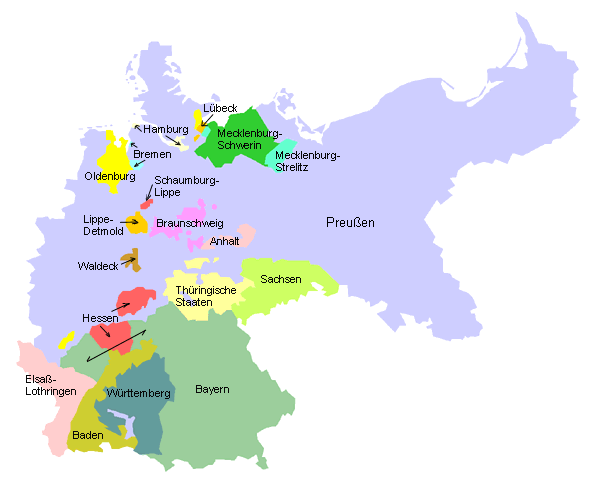
Quelle/Source: Volker Preuß
Country of Anhalt:
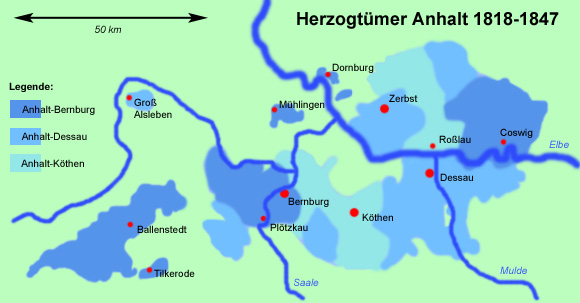
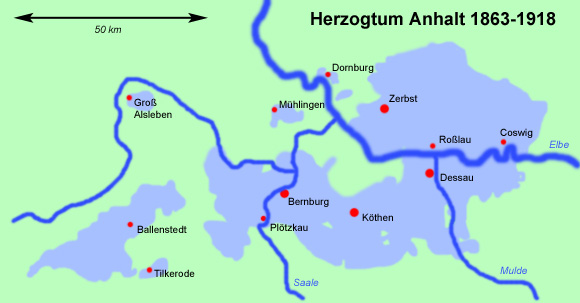
Quelle/Source: Volker Preuß

Area: ca. 893 square miles
Inhabitants: 351.000 (ca. 1930)
Capital: Dessau, 71.200 inh. (ca. 1930)
Currency to 1867: 1 Taler = 30 Silbergroschen = 360 Pfg.
Currency 1867–1875: 1 Taler = 30 Silbergroschen = 360 Pfg., 1 Gulden = 60 Kreuzer
Currency 1875–1924: 1 Mark = 100 Pfennig
Currency 1924–1948: 1 Reichsmark (RM) = 100 Reichspfennig (Rpf.)
Quelle/Source: Wahlen in der Weimarer Republik,
Der Michel

10th century · the family which was later referred as the Ascanians is mentioned in Swabia Gau
11th to 12th century · the Ascanians consolidate their possessions around the castles of Ballenstedt, Aschersleben and Anhalt
1157–1320 · the Ascanians are the Margraves of Brandenburg
1180–1422 · the Ascanians are the Dukes of Saxony
1252 · Birth of Henry I., he called itself as the first as "Prince of Anhalt"
1252 · inheritance, it arise the principalities of Anhalt-Aschersleben (until 1315), Anhalt-Bernburg (until 1468), Anhalt-Zerbst (until 1570)
1396 · inheritance of the Principality of Anhalt-Zerbst, it arise the principalities of Anhalt-Dessau and Anhalt-Köthen
1570 · death of Prince Bernhard of Anhalt-Zerbst, extinguish of all offshoot lines, Prince Joachim Ernst von Anhalt-Dessau rules over the entire Principality of Anhalt
1606 · inheritance of the Principality of Anhalt, it arise the Principalities of Anhalt-Dessau, Anhalt-Bernburg, Anhalt-Köthen and Anhalt-Zerbst
1611 · establish of the nominal Principality of Anhalt-Plötzkau (under the sovereignty of Anhalt-Bernburg)
from 1635 · the Princes of Anhalt, received a common voice in the Imperial Council, and determine the oldest to the spokesman for the entire house
1665 · extinguish of the line of Anhalt-Köthen, the line of Anhalt-Plötzkau inherits the Principality of Anhalt-Köthen, arise of the line Anhalt-Köthen-Plötzkau
1765 · establish of the line of Anhalt-Köthen-Pless by Anhalt-Köthen-Plötzkau
1667 · the principality of Anhalt-Zerbst, inherits Jever County in Friesland
1793 · extinguish of the line of Anhalt-Zerbst
1797 · the principality of Anhalt-Zerbst becomes splited between the principalities of Anhalt-Dessau, Anhalt-Bernburg and Anhalt-Köthen
1806 · Anhalt-Bernburg becomes levied to a Duchy by the German emperor
1807 · joining tho the Rhine Confederation
1807 · Anhalt-Dessau and Anhalt-Köthen become levied to a Duchy by Napoléon
1815 · joining to the German Federation
1818 · extinguish of the line Anhalt-Köthen-Plötzkau, the Duchy of Anhalt-Köthen comes to the line of Anhalt-Köthen-Pless
1847 · extinguish of the in the Duchy of Anhalt-Köthen ruling line of Anhalt-Köthen-Pless, establish of a co-administration of the Duchies of Anhalt-Bernburg and Anhalt-Dessau for the Duchy of Anhalt-Köthen
1853 · annexation of the Duchy of Anhalt-Köthen to the Duchy of Anhalt-Dessau, establish of the Duchy of Anhalt-Dessau-Köthen
1863 · extinguish of the line of Anhalt-Bernburg, annexation of Anhalt-Bernburg to Anhalt-Dessau-Köthen, establish of the Duchy of Anhalt
1866 · in the Brother War on the hands of Prussia, joining to the North German Confederation
1871 · joining to the German Empire
1919 · fall of the monarchy, Free State
1934 · the territorial structure of the states of the German Empire becomes replaced by the districts of the NSDAP, the countries become meaningless
1945 · united with the Prussian Province of Saxony to the country "Province Saxony-Anhalt"

To explain the origin of the name "Anhalt" there exist various theories. It should point out to a castle, built by Esiko Count of Ballenstedt, without wood (on holt).
Quelle/Source: www.andat.de







![]()

